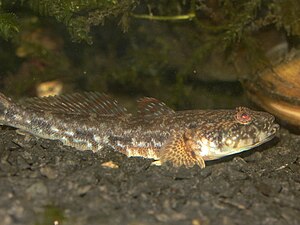Kessler goby
| Kessler goby | ||||||||||||
|---|---|---|---|---|---|---|---|---|---|---|---|---|

Kessler goby ( Ponticola kessleri ) |
||||||||||||
| Systematics | ||||||||||||
|
||||||||||||
| Scientific name | ||||||||||||
| Ponticola kessleri | ||||||||||||
| ( Günther , 1861) |
The Kessler goby ( Ponticola kessleri , Syn .: Neogobius kessleri ) is a Southeast European goby species . It got its name in honor of the ichthyologist Karl Fjodorowitsch Kessler .
features
The Kessler goby is 12 to 18, maximum 22 centimeters long. Your body is elongated, the head broad and flattened. The total length of the goby is 2.75 times the length of the head. The mouth is inclined, the lower jaw protrudes. The mouth is 1.5 to 2 times as long as the diameter of the eye. The top of the head and a third of the gill covers are scaly. In the middle longitudinal row of scales (mLR) there are 64 to 79 scales. The first of the two dorsal fins is supported by 5 to 6 fin spines, the second by a fin spine and 15 to 18 (mostly 16 to 18) articulated soft rays. The anal fin has a fin spine and 11 to 16 (mostly 12 to 15) articulated soft rays. The pelvic fins are pointed.
distribution
The Kessler goby occurs in the lower reaches and mouths of the Danube , Dniester , Southern Bug and in the Dnieper, as well as the adjacent, only slightly brackish areas of the Black Sea . It is missing in the Sea of Azov . In the last few decades the Kessler goby, like other Pontic gobies, has greatly expanded its range by migrating up the rivers. In 1979 it was detected in Lake Balaton , in 1984 in the Hungarian section of the Danube, in 2003 in Raab , on the border with Austria , October 2006 in the Rhine near Königswinter , 2008 in the Rhine near Duisburg , in March 2009 in the Dutch Lower Rhine and in autumn 2011 near Basel
Way of life
The Kessler goby is a bottom fish that lives in fresh and brackish water with low salinity, over stony and sandy soils. It feeds mainly on small crustaceans such as hover shrimp and amphipods , worms, molluscs and smaller fish. Kessler gobies usually spawn twice a year, from March to May. The territory-forming male guards the sticky eggs deposited on stones, mussels or water plants until the young fish hatch.
Systematics
The Kessler goby belongs to a subfamily of Pontic and North American gobies, the Benthophilinae, established in 1927 . Within the Benthophilinae it belongs to the tribe Ponticolini that was newly established in 2009 . The sister species is Ponticola eurycephalus , which is widespread in the Ukraine and therefore partly occurs in the same habitat.
literature
- Steinbach's naturalist guide, freshwater fish. Ulmer, Stuttgart 2003, ISBN 3-8001-4296-1 .
- ↑ van Kessel N., M. Dorenbosch, Spikmans F. (2009) First record of Pontian monkey goby, Neogobius fluviatilis (Pallas, 1814) in the Dutch Rhine. Aquatic Invasions, 4 (2): 421-424. ( PDF )
- ↑ Rheinfischereigenossenschaft - NRW Archived copy ( memento of the original from September 13, 2011 in the Internet Archive ) Info: The archive link was automatically inserted and not yet checked. Please check the original and archive link according to the instructions and then remove this notice.
- ↑ Office for Environment and Energy: INVASIVE GRUNDELN CONQUER THE RHINE ( PDF )
- ↑ Beling, DE & BS Iljin (1927): Benthophiloides brauneri ng, n. Sp. A new member of the Gobiidae family for the Black Sea basin. Trav. Sta. Biol. Dniepre, Acad. Sci. Ukraine , 3, 7, (2): 309-325.
- ^ Matthew E. Neilson, Carol A. Stepien (2009): Escape from the Ponto-Caspian: Evolution and biogeography of an endemic goby species flock (Benthophilinae: Gobiidae: Teleostei). Molecular Phylogenetics and Evolution , 52, (1): 84-102. doi : 10.1016 / j.ympev.2008.12.023
Web links
- Kessler goby on Fishbase.org (English)
- Ponticola kessleri inthe IUCN 2013 Red List of Threatened Species . Posted by: Freyhof, J., 2010. Retrieved February 8, 2014.
